April 30th, 2007
The Silk Road

Located at 4 Via Bartolini, the Florence silk factory and showroom of Antico Setificio Fiorentino (Antique Florentine Silk Factory) is a lovely little time capsule. Everything about it: The buildings, the interiors, the patterns, the fabrics, even the profusely blooming wisteria growing up the wall has the look of unstudied perfection. Here is the place where they still weave silk fabrics by hand on wooden looms, just as they did at the height of the Renaissance.
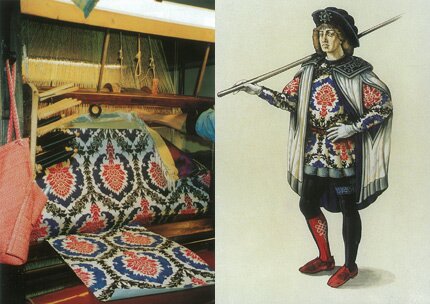
In fact, a visit to the Uffizi gallery down the street to study the paintings of the masters can also be a study of the silk damasks, brocades and the iridescent ermisino that clothe and adorn the painting’s subjects and participants and are painted with exquisite detail.

Alison and I visited the Antico Setificio on my recent Italy trip to get some inspiration for some of the designs for wall finishes we will be doing in her studio in San Bartolo on our October group trip. We will be doing one room with a combination of plasters and metallic waxes to replicate the look textural/smooth damasks that the factory creates (and that sell for upwards of $400/yd.) Another high-ceilinged room will have a deep frieze that resembles a valance similar in look to some of their custom fabrications for canopy beds that feature elaborate banding and trims. The factory is located in the Oltrarno area of Florence, close to many of the other artisan workshops. They welcome visitors here. You just have to ring the bell. If you can’t visit in person, there is a richly illustrated book available (sold only through them) and it’s photographs are featured here.
April 27th, 2007
Roman Wall Painting
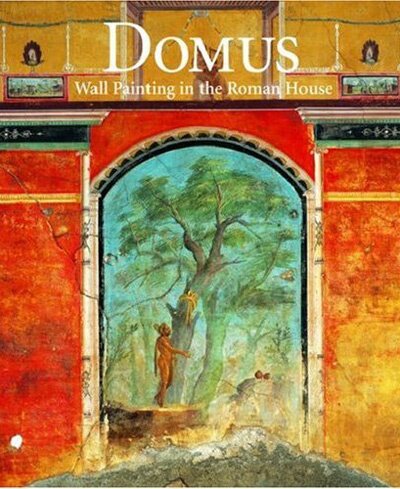
An absolutely magnificent book on Roman wall paintings is Domus: Wall Painting in the Roman House. It features very large, detailed and stunning pictures (WAY better than mine!) of numerous excavated villas in Pompeii and includes both the Villa Farnesina and Villa Livia from Rome. It’s a bit expensive, but well worth it as a collectors item and source of design and color inspiration!
April 26th, 2007
Villa Farnesina

Still on the second floor of the National Museum of Rome: Wall frescoes from the Villa della Farnesina. After coming home and doing some more research on this, I have found that these frescoes from the 3rd century were discovered and excavated in the late 18th century from the gardens of the current Villa della Farnesina. This villa, built in the Trastevere area of Rome on the banks of the Tiber was a quite large residential villa surrounded by lush gardens. They have been able to reconstruct several rooms from it at the museum, albeit with many pieces missing.
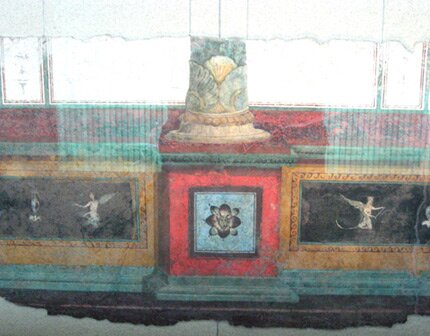
Behind a long glass case, they have assembled what is left of a long wall of panels and columns, part of which it shown above.
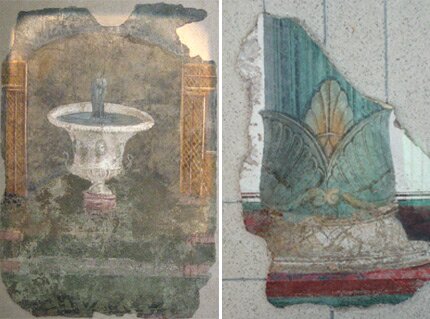
My favorite “antiquities” photo from the whole trip is the small, fractured piece of the delicate column base shown above, right. It’s hard to imagine how it would have felt to be surrounded daily by that much artistic and natural beauty!

The more recent Renaissance version of Villa della Farnesina is open to the public. In fact, there are many Roman Villas, many containing beautiful botanical gardens that are available for touring and can provide a welcome brake from the zipping cars and throngs of pedestrians and fill the streets and sidewalks of Rome. Since I tossed a coin into the Trevi fountain over my back, I am guaranteed a return to Rome some day and may make it a “Villa” trip!
April 24th, 2007
Roman Mosaics
Well, I am back from Italy much to quickly. I really miss the authentic cappucinos and the tangy yogurt, among a million other things! What I found I didn’t miss as much was not being tied to a computer and checking my email 100 times a day, so I am finding it a bit hard to get back into my electronic routines! My son dabbles in mosaics, so I was really excited to take him to the National Museum of Rome at the Palazzo Massimo. I’ve written about it here already, but I find the recovered antiquities there so stunning I’m going to post about it again!
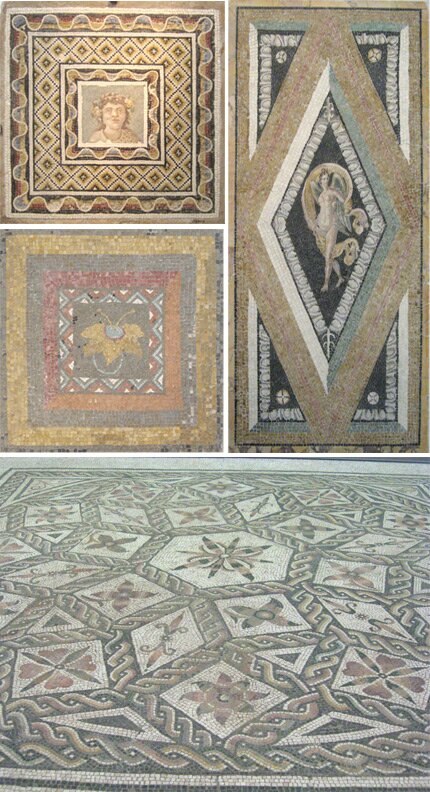
They have an amazing collection of mosaic pavements that were mostly discovered in the ruins of residential buildings of the city and suburbs of Rome around the end of the 19th century. Some of them are in near-perfect condition and the colors and quality of craftsmanship are amazing! While many examples there are of simpler, graphic designs that use black tesserae on a white background (less expensive and time consuming to produce), there are also many examples of more complicated polycrome techniques, like the ones shown above. The details and modeling that they were able to achieve with tiny, perfect squares of stone and marble is simply stunning. I especially love the ochres with blue-greens and the way they were able to achieve the classic egg and dart moldings. It’s inspiring and humbling all at once.
April 21st, 2007
Japanese Cranes
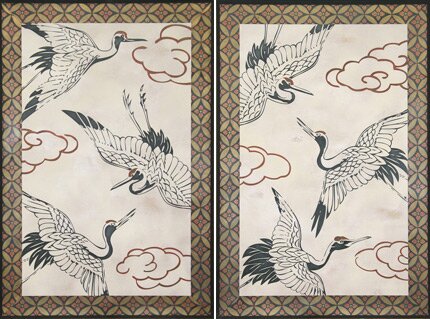
My dear friend Gary Lord is in the process of writing yet another book for Northlight. This one is on murals and will feature step by steps of a wide variety of mural projects. Taking a different approach, he has asked many different people in the industry to contribute projects, including me! Now, even though I wrote a book for Northlight myself back in 2000 called Trompe L’oeil Murals Using Stencils, I don’t consider myself a muralist. I actually much prefer 2-dimensional design and composing with patterns and textures. SO, I chose to do something quite simple and graphic (plus, I procrastinated and was really squeezed for time!)
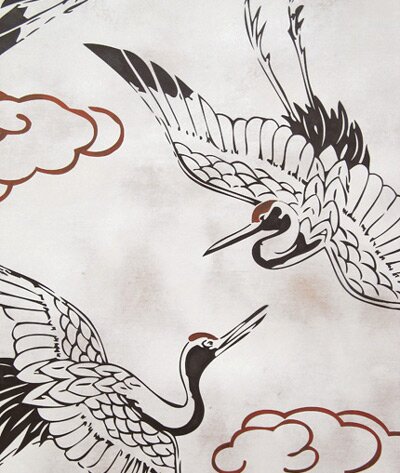
I have long wanted to develop these classic Japanese Cranes into Modello patterns, so this was the perfect opportunity! For the book project, I used the Floral Lattice stencil from Royal Design Studio, but we changed it up a bit for the new Modello Panels that we are offering. I troweled Lustestone, a metallic plaster material, over a gold metallic basecoat that had been rolled on pieces of Roclon canvas, so these could be hung from rods or simply wallpaper pasted to the wall. I was quite pleased with the way they turned out! The book will be available next Spring.
April 11th, 2007
Fortuny Fabric Fabulousness
When in Florence, Alison is going to take me to visit the Florentine silk factory and showroom of Antico Sertificio Fiorentino to get some inspiration for one of the wall finishes we will be doing in her studio. Fabric-inspired finishes, using stencils with paint, glaze, plasters, metallics or a combination of all of the above are some of my favorite wall treatments to both design and execute. I love to wrap a room with elegant allover pattern that looks as if it’s been aged over time. It’s a very “livable” look. Some of my favorite fabric inspirations over the years have come from the fabrics of the famed Mariano Fortuny.

His highly guarded secret methods have been attempted to be copied over the years by many, but no one has been able to equal the look of authentic antiquity. The factory now has been moved to an island location off the coast of Venice, and there is a Fortuny museum in that town.
April 3rd, 2007
Florence Art!
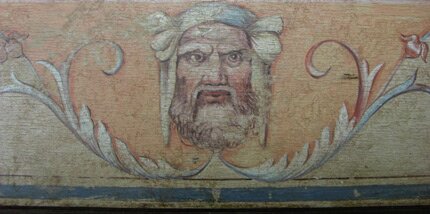
I wrote about my upcoming trip to Italy on the Art of Living blog, but wanted to talk a bit more about the project here. I am going to Rome and on to Florence next week to sort out the details of a trip that Gary Lord and I are hosting for a group of students next October.
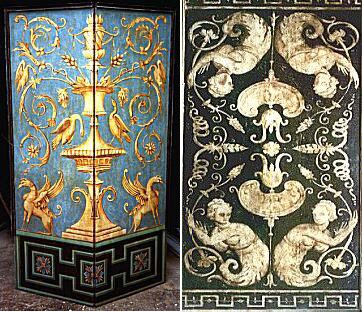
We have joined up with Alison Woolley Bulkghalter (whose exquisite work is shown above) to plan a program around doing some painted decoration in her new studio that is housed in a former small theatre built in the 1800′s. Alison runs a Florentine painting studio and offers art courses year round, both there and at the Maiano estate, where we will be staying.
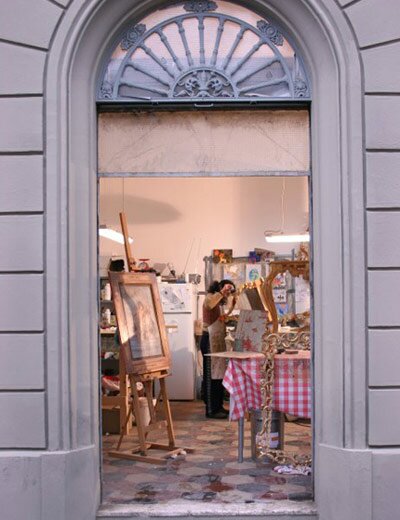
We will be using a decorative motif that was originally on the plaster ceilings and adapting it to create a design for a “faux marble” floor pattern that will be done with an integrally colored concrete overlayment. This will be set off with trompe l’oeil paneling around the dado with plaster columns. The back rooms will receive wall finishes designed to replicate the local Florentine silk fabrics. More about that “manana”, I mean “domani”. Oh yeah! Gotta start crammin on that Italian language CD.
April 2nd, 2007
In a Colorful Mood
So, I have started attempting to plan what types of design themes, color, patterns, etc. I will be decorating our new building with. Got my little design notebook going. It’s so cool to have all this design at my fingertips and have the ability to do anything I want! It’s such a burden to be able to to anything I want!! How do you narrow down a choice from “everything” to “something”?
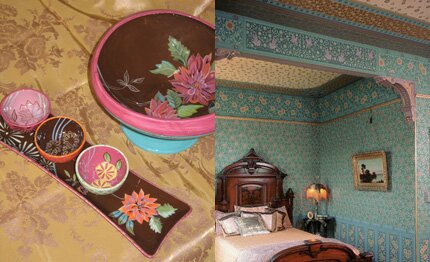
Answer: Find a theme and tease it out. For my office I’ve decided that my theme will be decidedly color decadent and follow the Aesthetic Design Movement battlecry “Art for art’s sake”. The photo at left shows some Tracy Porter ceramics I just bought on sale at Horchow. Love those colors and I think those little bowls will be perfect for holding paper clips and such! The right photo is from Bradbury and Bradbury. Somehow the Victorian love of combining dramatic colors with layered pattern is looking really fresh to me.
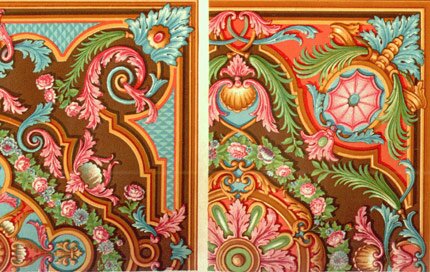
I am designing from the floor up. I have decided to have an unfinished wood floor installed and want to use a combination of new, custom designed Modello masking patterns and stencils to create lush surface of dark chocolate, teal, pink, green and gold. I love the look and feel of these 17th Century designs shown above and below.

Looking at some of the latest furniture from Anthropologie (below) I see that, yet again, those guys are following my lead. LOL. Personally, I think the 17th Century designs have a lot more legs, but I like the idea of being in good company all around.













 Copyright © Designamour
Copyright © Designamour